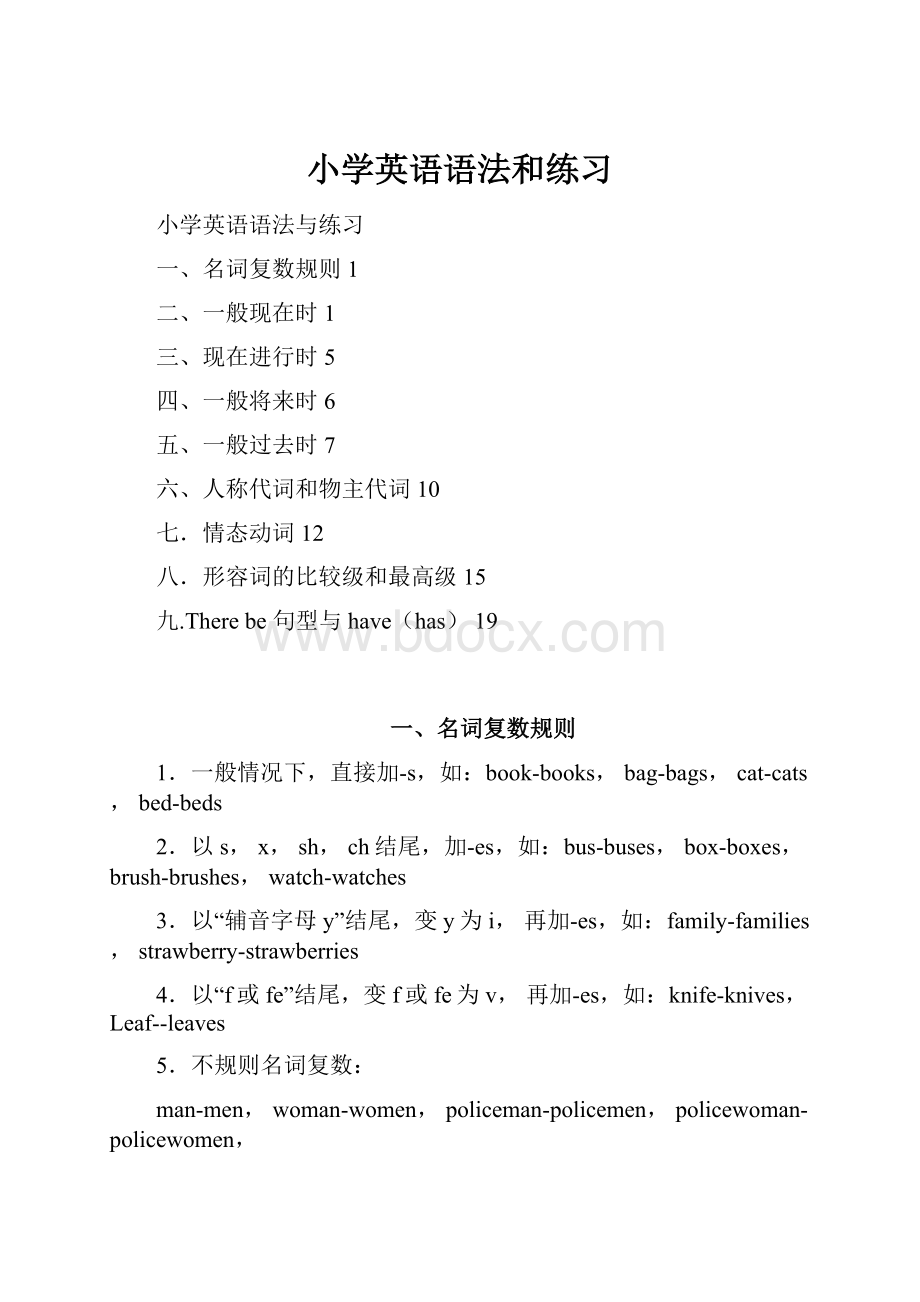 小学英语语法和练习.docx
小学英语语法和练习.docx
- 文档编号:29736343
- 上传时间:2023-07-26
- 格式:DOCX
- 页数:38
- 大小:36.07KB
小学英语语法和练习.docx
《小学英语语法和练习.docx》由会员分享,可在线阅读,更多相关《小学英语语法和练习.docx(38页珍藏版)》请在冰豆网上搜索。

小学英语语法和练习
小学英语语法与练习
一、名词复数规则1
二、一般现在时1
三、现在进行时5
四、一般将来时6
五、一般过去时7
六、人称代词和物主代词10
七.情态动词12
八.形容词的比较级和最高级15
九.Therebe句型与have(has)19
一、名词复数规则
1.一般情况下,直接加-s,如:
book-books,bag-bags,cat-cats,bed-beds
2.以s,x,sh,ch结尾,加-es,如:
bus-buses,box-boxes,brush-brushes,watch-watches
3.以“辅音字母y”结尾,变y为i,再加-es,如:
family-families,strawberry-strawberries
4.以“f或fe”结尾,变f或fe为v,再加-es,如:
knife-knives,Leaf--leaves
5.不规则名词复数:
man-men,woman-women,policeman-policemen,policewoman-policewomen,
child-children,foot-feet,tooth-teeth fish-fish,people-people,Chinese-Chinese,Japanese-Japanese
1.写出下列名词的复数。
watch_______child_______photo________diary______
day________foot________book_______dress________
tooth_______sheep______box_______strawberry_____
peach______sandwich______dish_______bus_______
man______woman_______paper_______people________
I_________he_________this___________she______
child_______photo________diary______day________foot________dress________
tooth_______sheep______box_______strawberry_____thief_______
yo-yo______sandwich______
二、一般现在时
一般现在时的be动词
be动词的用法:
(1)Iam,youare,weare,theyare,heis,sheis,itis.
口诀:
我用am,你用are,is用在他她它,复数全用are.
(2)肯定和否定句:
Iam(not)fromLondon.Heis(not)ateacher.
Sheis(not)inthediningroom.Myhairis(not)long.Hereyesare(not)small.
(3)一般疑问句:
AreyouaChinese?
Yes,Iam./No,Iamnot.
AretheyAmerican?
Yes,theyare./No,theyaren't.
Isthecatfat?
Yes,itis./No,itisn’t.
1.用am,is,are填空。
1.I______aboy.______youaboy?
No,I_____not.
2.Thegirl______Jack'ssister.
3.Thedog_______tallandfat.
4.Themanwithbigeyes_______ateacher.
5.______yourbrotherintheclassroom?
6.Where_____yourmother?
She______athome.
7.How_______yourfather?
8.MikeandLiuTao______atschool.
9.Whosedress______this?
10.Whosesocks______they?
2.用恰当的be动词填空.
1.I______aboy.______youaboy?
No,I_____not.
2.Thegirl______Jack'ssister.
3.Thedog_______tallandfat.
4.Themanwithbigeyes_______ateacher.
5.______yourbrotherintheclassroom?
6.Where_____yourmother?
She______athome.
7.How_______yourfather?
8.MikeandLiuTao______atschool.
9.Whosedress______this?
10.Whosesocks______they?
11.That______myredskirt.
12.Who______I?
13.Thejeans______onthedesk.
14.Here______ascarfforyou.
15.Here______somesweatersforyou.
16.Theblackgloves______forSuYang.
17.Thispairofgloves______forYangLing.
18.Thetwocupsofmilk_____forme.
19.Sometea______intheglass.
20.Gaoshan’sshirt_______overthere.
21.Mysister'sname______Nancy.
22.This______notWangFang’spencil.
23.______DavidandHelenfromEngland?
24.There______agirlintheroom.
25.There______someapplesonthetree.
26._______thereanykitesintheclassroom?
27._______thereanyapplejuiceinthebottle?
28.There_______somebreadontheplate.
29.There_______aboy,twogirls,threemenandtenwomeninthepark.
30.You,heandI______fromChina.
一般现在时的功能:
1.表示事物或人物的特征、状态.如:
Theskyisblue.天空是蓝色的.
2.表示经常性或习惯性的动作.如:
Igetupatsixeveryday.我天天六点起床.
3.表示客观现实.如:
Theearthgoesaroundthesun.地球绕着太阳转.
一般现在时的构成:
1.be动词:
主语+be(am,is,are)+其它,如:
Iamaboy.我是一个男孩.
2.行为动词:
主语+行为动词+(其它),如:
WestudyEnglish.我们学习英语.
当主语为第三人称单数(he,she,it,Tom,Amy,thedog…)时,要在动词后加“-s”或“-es”,如:
MarylikesChinese.玛丽喜欢汉语.
一般现在时的否定句:
主语+benot+其它.
如:
Heisnotaworker.他不是工人.
缩写:
isnot=isn'tarenot=aren't
一般现在时的一般疑问句:
Be+主语+其它?
(把Be提到句首)
如:
-Areyouastudent?
-Yes,Iam./No,I'mnot.
特殊疑问句:
疑问词+一般疑问句?
如:
Whereismybike?
3.行为动词的变化.
否定句:
主语+don't(doesn't)+动词原形+(其它).如:
Idon'tlikebread.
当主语为第三人称单数时,要用doesn't构成否定句.如:
Hedoesn'toftenplay.
一般疑问句:
Do(Does)+主语+动词原形+其它?
如:
-Doyouoftenplayfootball?
-Yes,Ido./No,Idon't.
当主语为第三人称单数时,要用does构成一般疑问句.如:
-Doesshegotoworkbybike?
-Yes,shedoes./No,shedoesn't.
4.动词第三人称单数的变化规则:
①一般情况下,直接加-s,如:
cook-cooks,milk-milks
②以s,x,sh,ch,o结尾,加-es,读[iz],如:
guess-guesses,wash-washes,watch-watches,go-goes
③以“辅音字母y”结尾,变y为i,再加-es,如:
study-studies
加s或es时,在清辅音后读[s],在浊辅音后读[z]。
一、写出下列动词的第三人称单数形式。
drink________go_______stay________make________
look_________have_______pass_______carry____
come________watch______plant_______fly________
study_______brush________do_________teach_______
wash_______
二、用括号内动词的适当形式填空.
1.Heoften________(have)dinnerathome.
2.DanielandTommy_______(be)inClassOne.
3.We_______(notwatch)TVonMonday.
4.Nick_______(notgo)tothezooonSunday.
5.______they________(like)theWorldCup?
6.What_______theyoften_______(do)onSaturdays?
7._______yourparents_______(read)newspaperseveryday?
8.Thegirl_______(teach)usEnglishonSundays.
9.SheandI________(take)awalktogethereveryevening.
10.There________(be)somewaterinthebottle.
11.Mike_______(like)cooking.
12.They_______(have)thesamehobby.
13.Myaunt_______(look)afterherbabycarefully.
14.Youalways_______(do)yourhomeworkwell.
15.I_______(be)ill.I'mstayinginbed.
16.She_______(go)toschoolfromMondaytoFriday.
17.LiuTao_______(do)notlikePE.
18.Thechildoften_______(watch)TVintheevening.
19.SuHaiandSuYang_______(have)eightlessonsthisterm.
20.-Whatday_______(be)ittoday?
-It’sSaturday.
三.写出下列动词的第三人称单数.
drink________go_______stay________make________look_________
have_______pass_______carry____come________watch______
plant_______fly________study_______brush________teach_______
四、按照要求改写句子.
1.DanielwatchesTVeveryevening.(改为否定句)
___________________________________________________
2.Idomyhomeworkeveryday.(改为一般疑问句,作否定回答)
________________________________________________________
3.Shelikesmilk.(改为一般疑问句,作肯定回答)
________________________________________________________
4.Amylikesplayingcomputergames.(改为一般疑问句,作否定回答)
___________________________________________________
5.Wegotoschooleverymorning.(改为否定句)
_______________________________________________________
6.HespeaksEnglishverywell.(改为否定句)
___________________________________________________
7.Iliketakingphotosinthepark.(对划线部分提问)
________________________________________________________
8.JohncomesfromCanada.(对划线部分提问)
___________________________________________________
9.Sheisalwaysagoodstudent.(改为一般疑问句,作否定回答)
________________________________________________________
10.SimonandDaniellikegoingskating.(改为否定句)
___________________________________________________
五、改错(划出错误的地方,将正确的写在横线上)
1.IsyourbrotherspeakEnglish?
__________________
2.Doeshelikesgoingfishing?
__________________
3.Helikesplaygamesafterclass.__________________
4.Mr.WuteachsusEnglish.__________________
5.Shedon'tdoherhomeworkonSundays._________________
三、现在进行时
1.现在进行时表示现在正在进行或发生的动作,也可表示当前一段时间内的活动或现阶段正在进行的动作.
2.现在进行时的肯定句基本结构为:
主语+be+动词ing+其他.
3.现在进行时的否定句:
在be后加not.主语+benot+动词ing+其他
4.现在进行时的一般疑问句:
把be动词提到句首,句后为“?
”:
Be+主语+动词ing+其他?
5.现在进行时的特殊疑问的基本结构为:
疑问词+be+主语+动词ing+其他?
(What,When,Where,How,Whose…)
但疑问词当主语时,其结构为:
疑问词(Who)+be+动词ing?
动词加ing(现在分词)的变化规则:
1.一般情况下,直接加ing,如:
cook-cooking
2.以不发音的e结尾,去e加ing,如:
make-making,taste-tasting
3.假如末尾是一个元音字母和一个辅音字母(重读闭音节),双写末尾的辅音字母,再加ing,如:
run-running,stop-stopping
一、写出下列动词的现在分词:
play________run__________swim_________make__________
go_________like________write________ski___________
read________have_________sing________dance_________
put_________see________buy_________love____________
live_______take_________come________get_________
stop_________sit________begin________shop___________
二、用所给的动词的正确形式填空:
1.Theboy__________________(draw)apicturenow.
2.Listen!
Somegirls_______________(sing)intheclassroom.
3.Mymother_________________(cook)somenicefoodnow.
4.What_____you______(do)now?
5.Look!
They_______________(have)anEnglishlesson.
6.They____________(notwater)theflowersnow.
7.Look!
thegirls________________(dance)intheclassroom.
8.Whatisourgranddaughterdoing?
She_________(listen)tomusic.
9.It's5o’clock.We_____________(have)suppernow。
10.______Helen____________(wash)clothes?
Yes,sheis.
三、句型转换:
1.Theyaredoinghousework.(分别改成一般疑问句和否定句)
_____________________________________________________________
_____________________________________________________________
2.Thestudentsarecleaningtheclassroom.(改一般疑问句并作肯定和否定回答)
_________________________________________________________________
_________________________________________________________________
3.I’mplayingthefootball(intheplayground).(对划线部分进行提问)
_________________________________________________________________
4.Tomis(readingbooks)inhisstudy.(对划线部分进行提问)
_________________________________________________________________
四、一般将来时
1、概念:
表示将要发生的动作或存在的状态及打算、计划或准备做某事.句中一般有以下时间状语:
tomorrow,nextday(week,month,year…),soon,thedayaftertomorrow(后天)等.
2、基本结构:
①begoingto+do;②will+do.
3、否定句:
在be动词(am,is,are)l后加not或情态动词will后加not成won't.
例如:
I’mgoingtohaveapicnicthisafternoon.→I'mnotgoingtohaveapicnic
thisafternoon.
4、一般疑问句:
be或will提到句首,some改为any,and改为or,第一二人称互换.
例如:
Wearegoingtogoonanoutingthisweekend.→Areyougoingtogoonanoutingthisweekend?
5、对划线部分提问:
一般情况,一般将来时的对划线部分有三种情况.
a.问人Who例如:
I’mgoingtoNewYorksoon.→Who'sgoingtoNewYorksoon?
b.问干什么What…do.例如:
Myfatherisgoingtowatcharacewithmethisafternoon.→Whatisyourfathergoingtodowithyouthisafternoon?
c.问什么时候.When.例如:
She’sgoingtogotobedatnine
- 配套讲稿:
如PPT文件的首页显示word图标,表示该PPT已包含配套word讲稿。双击word图标可打开word文档。
- 特殊限制:
部分文档作品中含有的国旗、国徽等图片,仅作为作品整体效果示例展示,禁止商用。设计者仅对作品中独创性部分享有著作权。
- 关 键 词:
- 小学英语 语法 练习
 冰豆网所有资源均是用户自行上传分享,仅供网友学习交流,未经上传用户书面授权,请勿作他用。
冰豆网所有资源均是用户自行上传分享,仅供网友学习交流,未经上传用户书面授权,请勿作他用。


 《贝的故事》教案4.docx
《贝的故事》教案4.docx
